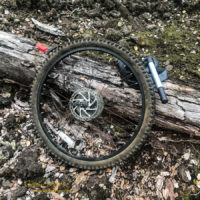This week I returned to Puʻuwaʻawaʻa.
The plan was to use a mountain bike this time. One nagging issue in hiking Puʻuwaʻawaʻa is the long access road you need to hike just to get to the base of the puʻu. Two miles of straight, and mostly paved road to climb before the hike really gets interesting.
It is old pavement, but in good shape as there is little more than foot traffic. Last time hiking out I wished I had a bike so those two miles would be one smooth downhill roll back to the vehicle. Once above the puʻu I could use the bike to explore the network of ranch roads that lead back into the forest reserve.
That was the plan, reality did not work out quite as well.
I arrive as the first rays of sunlight hit the puffs of cloud overhead. A pretty morning, one that bodes well. I am looking forward to a day exploring the ʻōhiʻa forest above Puʻuwaʻawaʻa.
Those roads behind the pu’u turn out to be pretty rough, in many places the sort of fist sized cobble that are trouble on the bike. Rolling and sliding under the tires. I ended up having to walk more than I hoped across those areas.
The other trouble was tires. First I find I have a slow leak in the front tire. Not a bad leak and I have a good pump along, but I was thinking of changing the tube. Then the rear tire goes flat.
I sit down in the shade of a pretty ʻōhiʻa tree to change out the rear with the spare tube. Oh joy… The new tube has a Presta valve stem, not Schrader. I spend a few minutes wondering what the plan is now before I figure out that my pump can be reconfigured to fit a Presta valve by opening up the end and flipping a part over.
The new tube gets me about 1/4 mile and goes flat. Yeah, it is going to be like that.
I pull the new tube out to find it has a manufacturing defect, split along the seam. Just the way this day is going.
Pulling out the original tube I reactivate the backup plan I was considering when I found the Presta valve… I find the leak and apply one of the two patches I have in the kit. Fortunately a neat pinhole leak in the outside face. It is an old and somewhat doubtful patch, but it seems to bond and hold pressure.
Spend a few moments pumping on the front tire too, it still has that slow leak.
Another couple miles later the rear is flat again. I use the second patch. Yes, I have now had the tire off and apart three times. It holds pressure, sorta. I have to stop every mile and pump it up again, but it does get me back to the vehicle.
At this point I have been on the trail much longer than planned, as I was putting the tire back on the bike the fog and mist arrive. I do not mind getting wet, rather cool and pleasant, a nice change from the hot Sun earlier. As I roll back down to the puʻu I enjoy the changed scenery. Old gnarled ʻōhiʻa trees loom in the fog about the path.
I did get to a few of the places I intended, and explored some of the road I had spied on the satellite photos. Old ranch cabins, collapsed redwood water tanks, and stone walls attest to a long history of cattle ranching in the area.
I locate an entrance into a lava tube complex known as Shangri-La. No idea where the name comes from, the name Shangri-La appears on the Puʻuwaʻawaʻa area resource management plan maps. No exploration into the tube, that is not allowed here, I do photograph the fern covered entrance.
In the end I enjoy speeding down the road back to the parking area, a couple miles of smooth pavement such a contrast to the rough lava roads above.






Nice report Andrew
Shangri-La was the cabin on the hill at Puuwaawaa Ranch. I forgot which family owned the ranch and who lived there but one of the women used the cabin as a getaway and would go there with a ladyfriend (this was back in the 1930s?). Speculation is that they were ‘special friends’ and went there to be alone together and away from the bustle of the ranch. The cabin was also stocked and supposedly a place to go to in case the Japanese invaded the island. She would go up there away from the main ranch buildings.
I went there only once with Kona Historical Society on a jeep tour, historians were there and told us about the cabin and the ranch.
Unfortunately in the 1990s a group, they were authorized as they were part of the ranch or visitors studying the area, went to the Shangri-La cabin and left. It was so dry and the overgrown grass caught fire from the catalytic converter of the vehicle. As they were leaving they saw the smoke and went back but it was too late as the grass fire quickly spread and flames destroyed the cabin. That’s why you won’t find the cabin there anymore.
Paniolo who still worked and some that retired from the ranch talked about how the common spoken language on the ranch was Hawaiian. They said haoles spoke English, the Japanese spoke Japanese, Portuguese didn’t speak English, Filipinos didn’t speak English. It was a mosaic of cultures working there so the common language became Hawaiian. They also said that as boys they’d ride their horses down to the ocean for a very early morning swim, then ride back up the ranch for a full day’s work.
Thanks for the background Baron!